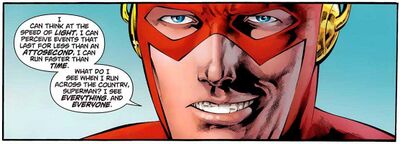The official discord link if you wish to join the discord: https://discord.gg/j5RKwCvAFu
Support the wiki on our official Ko-Fi page or Patreon page!
Reactions

Reactions
In fiction, movement over long distances and movement over short distances - which can be dubbed "combat distances" - tend to be remarkably different for different characters, resulting in serious discrepancies when considering their overall speed. On this wiki, we, therefore, differentiate between various types of speed, including reaction speed.
Reaction speed is defined as a single movement in a defined timeframe, which a character has been shown capable of. A series of movements in similar timeframes makes this combat speed, so this term should only be applied for a single, quick movement. Examples include ducking backward to dodge bullets and diving away to dodge extremely fast vehicles.
When measured in terms of a single movement of often undefined, small distance, humans have displayed between 300 milliseconds (subhuman) to 100 milliseconds (peak human) reactions. Autonomous body reactions for humans can also reach as high as 40 milliseconds, but this is oftentimes inapplicable to reaction speed and shouldn't be used.
Rules Regarding Reaction Speed and Scaling
- Reaction speed has both a distance and a timeframe component, so all calculations that are completed for reaction speed cannot simply be a timeframe by itself. Do not randomly assume a 1-meter distance for each timeframe and use that speed for the reaction speed.
- If only a timeframe is known (for example, characters who do not need to move to attack or defend), then it is still possible to list that timeframe in parenthesis in the speed section of the character profile. It may also be listed in the skills section of the profile or as a feat.
- If character A can blitz character B, A's movement speed may be scaled to B's reaction speed.
- If character A is considered an equal in combat to character B, then reaction speed may be scaled if there are no discrepancies or showings that suggest the opposite.
- All other scalings of reaction speed are circumstantial and must be discussed with the staff.
Reaction Tiers for Reaction Timeframes Only
Normal Human perception: 0.3-0.129 seconds
Athletic Human perception: 0.129-0.102 seconds
Peak Human perception: 0.102-0.08 seconds
Superhuman perception: 0.08-0.0291 seconds
Subsonic perception: 0.0291-0.00583 seconds
Subsonic+ perception: 0.00583-0.0032 seconds
Transonic perception: 0.0032-0.00265 seconds
Supersonic perception: 0.00265-0.00117 seconds
Supersonic+ perception: 0.00117-0.00058 seconds
Hypersonic perception: 0.00058-0.000294 seconds
Hypersonic+ perception: 0.000294-0.000117 seconds
High Hypersonic perception: 0.000117-0.0000588 seconds
High Hypersonic+ perception: 0.0000588-0.0000294 seconds
Massively Hypersonic perception: 0.0000294-0.00000294 seconds
Massively Hypersonic+ perception: 0.00000294-0.0000003336 seconds
Sub-Relativistic perception: 0.0000003336-0.0000000667 seconds
Sub-Relativistic+ perception: 0.0000000667-0.00000003336 seconds
Relativistic perception: 0.00000003336-0.00000000667 seconds
Relativistic+ perception: 0.00000000667-0.000000003336 seconds
Speed of Light perception: 0.000000003336 seconds
FTL perception: 0.000000003336-0.0000000003336 seconds
FTL+ perception: 0.0000000003336-0.00000000003336 seconds
Massively FTL perception: 0.00000000003336-0.000000000003336 seconds
Massively FTL+ perception: any real number less than 0.000000000003336 seconds
Note: Credits to VSBW for the page.
